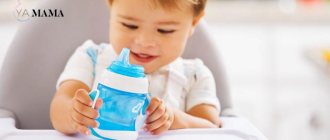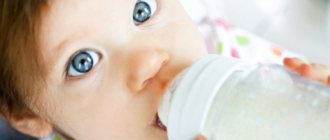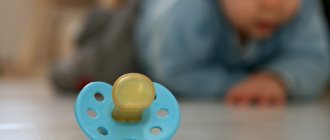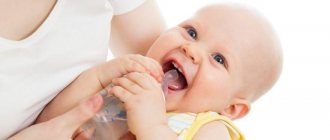In the first half of his life, the baby receives everything he needs for growth and development with his mother’s milk - with natural feeding, or by drinking formula and water from a bottle with a pacifier - with artificial feeding.
But by the age of one year, pediatricians advise teaching a child to confidently hold a cup and drink from it.
To make the transition from a bottle smooth and calm, it is good to use special baby sippy cups.
Varieties
The modern market for sippy cups for children is huge and diverse. Design features depend on the purpose of the model and the age of the baby for whom it is created.
The following types of sippy cups are distinguished:
- educational - for the little ones;
- sippy cup - for children from six months;
- sippy cup with straw - for infants from 8-9 months;
- a classic model with a nozzle with a spout - for one-year-olds;
- Thermal drinker is a walking option.
The first sippy cup is better to buy a training one: its configuration includes several attachments, primarily a nipple and a soft spout. This model can be used even before the age of six months. Sippy cups for small children are usually easy to hold and have comfortable handles or handles.
The design of the sippy cup includes a valve that opens only when drinking. It is placed either in the spout or in a round insert, thanks to which the baby can drink liquid from any edge.
The reliable design of the sippy cup will not allow the drink to leak out, even if the baby throws it or starts shaking it, which he often likes to do with dishes. The option is very convenient for traveling and walking.
a sippy cup with a straw to a baby who refuses the classic models. Children may find it interesting to suck in water or juice through a straw inserted into the lid. It is important to change the straw regularly as it can be difficult to clean. The drink remaining on the walls of the tube contributes to the appearance and spread of pathogenic bacteria.
A classic sippy cup is suitable for older children, when they already hold it confidently and do not tip it over. This model is convenient for use at home: the child can drink carefully without spilling the drink on himself. This option is not particularly good for walking, as liquid will leak out if you tilt too much.
A transparent sippy cup is the most preferred option
Thermal drinkers are made of two containers built into each other, which allows this model to maintain the temperature of the drink for several hours. This feature allows parents to take water or juice for their child for a walk in cold weather.
Products with two spouts are interesting : the baby can drink from the soft one and gnaw on the harder one when he is teething.
When choosing a sippy cup, you must pay attention to the following points:
- Product certification. It is important to be sure that your cookware is safe for children.
- Quality of plastic. It should not have an unpleasant odor, indicating the presence of harmful impurities.
- The presence of a measuring scale and transparent walls will allow you to dose the liquid correctly.
- Model volume. The younger the child, the smaller the container should be.
- The shape of a bottle or cup, the presence of handles. You should select a sippy cup taking into account the baby’s ability to hold an object. For little ones, it is better to choose a model with removable rubberized handles.
- After removing the nozzle, the universal sippy cup should have smooth, jagged edges. This will avoid possible injury.
- The rubberized bottom will prevent frequent falls.
- Having a cap that covers the spout will help prevent dust from getting in.
How to use a sippy cup correctly?
Using a sippy cup may seem easy, but there are pitfalls that are important to be aware of:
- Never allow your child to drink juice or milk while lying in bed, or to walk around with a sippy cup in hand for several hours at a time. When he is thirsty, it is better to give him water before his main meal instead of juice or milk. Otherwise, sugar may accumulate in the baby’s mouth, which will create a favorable environment for the development of caries.
- Wash the cup (especially the lid and plastic stopper) thoroughly between uses. Liquid can easily get into the nooks and crannies of the cup and valve, causing bacteria and mold to grow. If you can't wash the sippy cup right now, at least give it a good rinse. If this is not possible, drain the unnecessary liquid and disassemble the sippy cup. Periodically check caps and valves for damage or mold.
- Don't expect a sippy cup to be the magic solution to ending breastfeeding. For some children, it simply replaces the bottle, and in the future you will also have to wean your baby off it. However, many parents find a sippy cup more acceptable for their child. When used correctly, it is not that harmful to teeth.
- Do not use the sippy cup for too long. Once your child gets the hang of it, switch to a regular cup. By age 2, most babies can drink from an open cup with two handles.
When can you start training your baby?
There is an opinion that it does not matter when a child starts drinking from a sippy cup or mug.
Some mothers offer their 2-3 year old baby a bottle with a nipple and think that this is normal.
Orthodontists do not recommend delaying the transition to a cup so that the baby’s bite is formed correctly.
Learning to confidently hold a sippy cup and drink from it requires a certain coordination of movements and intelligence from the baby. The realization that he knows how to drink liquid in the same way as mom and dad gives the baby confidence in his abilities and a sense of community with older family members.
Some children master the sippy cup as early as 5-6 months, when they begin to sit. For babies of this age, it is better to choose a sippy cup with a silicone nozzle that resembles a pacifier in shape.
The most favorable time for weaning from the bottle, according to pediatricians, is the age of 7-8 months. At this stage of development, children sit confidently and hold objects well.
By 10-12 months, it is quite possible for a child to buy a universal sippy cup, in which, if desired, the nozzle can be removed, turning it into a real mug.
When offering her child a sippy cup for the first time, the mother needs to be attentive to the baby’s wishes and skills. Only the person closest to the child will understand whether it is time for him to replace the bottle with more adult dishes. The opinions of neighbors and friends should not be of paramount importance in this matter.
How to train?
There are children who quickly understand what to do with a sippy cup and immediately begin to use it correctly.
Most children need time to master this skill, so it is important for parents to be patient and support their child.
Do not suddenly give up the bottle by purchasing a sippy cup.
If your baby uses formula, a sippy cup is convenient to use for supplementation.
To ensure that learning a new skill goes smoothly, you should follow certain recommendations:
- Until the child learns to confidently use a sippy cup, it is better to simply pour water into it. Compotes, fruit drinks and juices are suitable for children who are already accustomed to this method of drinking.
- By putting a waterproof bib or apron on your baby, you will be able to avoid additional washing.
- It is advisable to drink at the children's table, and not on the crib or sofa.
- You should not be allowed to play with a sippy cup; the child must understand that it is needed for drinking.
- When choosing a sippy cup, it is important to consider the age of the baby. It is much easier for a child to learn a new skill using the right dishes.
The child drinks on his own
Following a simple algorithm, it is not difficult to teach a child to use a sippy cup:
- Show the baby the sippy cup and tell him why it is needed.
- Let the baby see how mom or dad holds a mug and how they drink.
- On the advice of experienced parents, you can lubricate the spout of the sippy cup with breast milk or formula.
- If the child is not yet 6 months old, it is recommended to touch the silicone nozzle to the roof of the mouth, which triggers a sucking reflex.
- When you bring the sippy cup to your baby, you need to tilt it slightly and allow the baby to take a sip. It is important that the child does not choke!
- For the first time, the mother has to hold the sippy cup, but if the baby wants to take it himself, he must be allowed to do so.
- You should definitely praise your child, even if something didn’t work out right away.
What and how much can you give your child in a sippy cup?
If your baby is under 6 months old, simply offer a serving of breast milk or formula in a sippy cup every day.
As a rule, breastfed or bottle-fed babies do not need water or juice for the first six months of life. Remember that babies under one year old should not be given cow's milk.
If your 6-month-old is thirsty between feedings, fill his sippy cup with water. Children aged six months and older can have up to 120 ml of 100% fruit juice per day as an addition to formula or breast milk. But don't offer it before bed to prevent tooth decay.
As soon as a child begins to drink whole milk (after reaching 1 year), experts recommend giving no more than 960 ml of milk and half a glass of juice per day. Otherwise, this will lead to caries, and the baby will most likely be full before the main meal.
What to do if the child does not want to drink from the sippy cup?
Sometimes a child fails to master a sippy cup or simply does not want to use it. What should mom do in this case?
- You can’t scold your child if something doesn’t work out for him. Support from a loved one and a positive attitude are important.
- It is necessary to postpone training if the child is sick or teething. It is better to offer him the usual bottle at this time.
- You can try to choose another, more convenient model. For example, with a silicone spout instead of a hard one. Older children may be interested in a sippy cup with a straw.
- It is better to choose a bright sippy cup for a child, with pictures, to attract the baby’s attention.
What types of baby sippy cups are there?
The undoubted advantage of a sippy cup is that it is less harmful to the baby’s teeth, if, of course, it is used correctly. The lid prevents your baby from getting wet, and the spout with holes prevents your baby from swallowing too much.
Children's sippy cups differ not only in color and picture. Both lids (with or without threads), handles, and spouts vary. Some sippy cups are very inconvenient and the baby has to throw the sippy cup up very hard in order for something to flow out of it.
There are also tumbler sippy cups. They are quite practical, especially if your child has a habit of throwing everything that comes to hand on the floor. This type of sippy cup will always land on the bottom.
Children's sippy cups also differ according to the recommended age of the child indicated on the packaging. In the case of sippy cups, this division is very arbitrary, but from it you can understand the intensity of the flow or, more simply, the size of the holes. Pay attention to this when choosing.
The use of sippy cups helps not only wean the baby off the bottle, but also trains the baby’s coordination and teaches him to bring the cup to his mouth independently. And at the same time, such a cup reduces your worries to a minimum. The child remains dry and clean.











